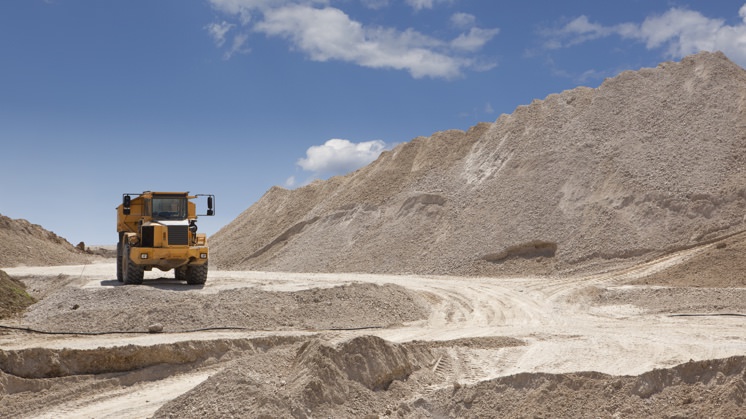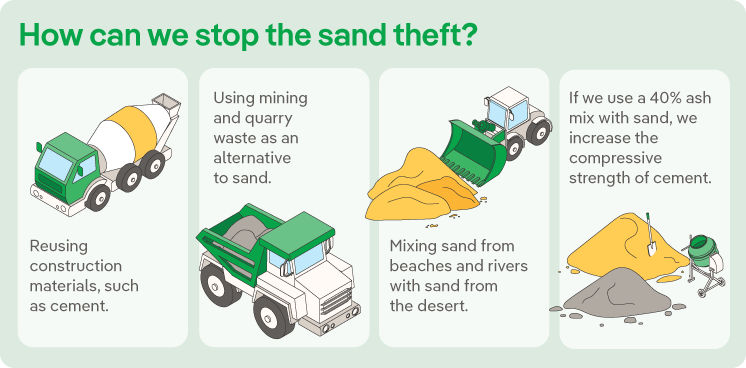What is sand theft and why does it exist?
The sand theft, a phenomenon which has devastating environmental effects
Sand is, after water, the most sought after natural resource. It is an essential component in the manufacture of electronic devices and glass, and it is also used in bulk in construction. Rapid population growth and the mass development of cities have turned this material into a scarce commodity and a very lucrative business has emerged in trading sand. The sand theft is a real threat to the environment.

Everything around us contains sand, from plastics to cosmetic products, to household appliances. Even toothpaste contains this type of material — a maximum of 20% —, but the main use of sand is in the construction industry: millions of sand are used every year to make cement, asphalt, etc.
According to the United Nations Environment Programme's most recent report on the subject, published in 2022 under the title Sand and Sustainability: 10 strategic recommendations to avert a crisis, 50 billion tonnes of sand are mined every year without adequate monitoring of the impact of this activity on nature. This makes sand, gravel and all other materials related to crushed stone the second most exploited natural resource in the world after water.
What happens to stolen sand?
Urbanisation is not going to slow down. According the same UN report, in 2020, 56% of the world's population lived in urban areas and the figure is expected to increase to 68.3% by 2050. Countries like Singapore or Dubai import sand — both legally and illegally — to reclaim land from the sea and create artificial islands. The mega-cities in India or Nigeria are growing relentlessly and its urbanisation devours huge amounts of sand.


As the UN report shows, as cities expand and urban infrastructure improves, the demand for sand also increases. This is mainly because more than half of this resource is dedicated to meeting the needs of the construction sector, which is responsible for future housing, hospital and school projects, as well as roads, bridges and key infrastructure for human development. On the other hand, there is also the growth of illegal and unregulated activities of sand mining groups.
The organisation itself points out that the trafficking of sand is a very lucrative business. In Morocco, to cite just one example, half the sand (about 10 million cubic metres per year) comes from the illegal trafficking of sand from beaches. In this illegal trade, which is increasingly common in developing countries, traffickers use shovels, trucks, boats and even animals to plunder sand from beaches or rivers.
Sand, grain by grain
A handful of sand... 1,000,000 mineral grains subjected to intense processes of erosion and weathering.
An individual particle within that handful is known as a sand grain or clast.


The size of a grain of sand ranges between 0.0625 and 2 millimetres.
The shape of each grain of sand can vary
-
 Angular
Angular -
 Sub-angular
Sub-angular -
 Sub-rounded
Sub-rounded -
 Rounded
Rounded -
 Very rounded
Very rounded
Sand on the beach contains quartz, volcanic glass, olivine, garnet, basalt, as well as different magnetic minerals.
Sand is transported by wind and water, and deposited in the form of beaches, dunes and sandbanks.


Sandy soils have excellent drainage characteristics, which is why they are normally used for intensive agriculture.
The world average consumption has reached 50 billion tons of sand per year, and about 30 billion tons are destined for the manufacture of reinforced concrete.
-
 It is estimated that 200 tons of sand are needed to build a medium-sized house.
It is estimated that 200 tons of sand are needed to build a medium-sized house. -
 A hospital, 3,000 tons.
A hospital, 3,000 tons. -
 And, to build just one kilometre of motorway, 30,000 kilos of sand are required.
And, to build just one kilometre of motorway, 30,000 kilos of sand are required.
SEE INFOGRAPHIC: Sand, grain by grain [PDF] External link, opens in new window.
The devastating effects of sand theft
The huge demand for sand fuels the activity of illegal networks. The price per ton has shot up in recent years and these networks have plundered beaches in many countries such as Vietnam, Sierra Leone, India and Cape Verde — where sand extraction has been prohibited since 2002 —. In addition, several Cambodian rivers have seen their sand disappear, endangering crops and riverside villages, and in Indonesia some 25 islands have disappeared since 2000.
The environmental consequences of the excessive use of sand are devastating: it is estimated that half of the world's beaches could disappear by the end of this century. The dredging and extraction of sand from the bottom of the sea and rivers profoundly affects the environment in several ways:
- Biodiversity: with the disappearance of beaches and river banks, many species lose their natural habitat.
- Loss of land: islands and arable land disappear, both inland and in coastal areas.
- Hydrological aspects: rivers change their course, causing high water levels and floods, also tidal cycles are altered.
- Water quality: water can become contaminated as a result of landslides, making it no longer suitable for human consumption.
- Infrastructure: water level rises in rivers damage bridges, houses, wharves and reservoirs.
- Climate: directly, through contamination by the extraction and transport of sand, and indirectly, through the production of cement or asphalt.
- Landscape: coastal erosion, changes in deltas and river mouths, etc.
- Decreased protection against extreme events: floods, droughts, maritime storms with sizeable waves, etc., have a greater effect because of the destruction of beaches and riverbanks.
Effective alternatives to avoid the sand theft
In order to reverse this situation and reduce the consumption of sand around the world, the UN proposes several measures.


Committing to these initiatives seems even more urgent if we take into account that sand is a natural resource, which is formed in a slow process, and that the consequences of the over-exploitation of non-renewable natural resources has its own effects.




